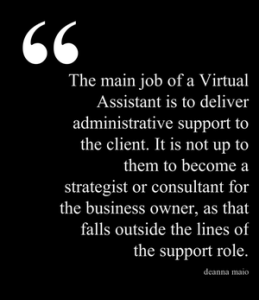I have to admit that I too have heard some disheartening things about working with virtual assistants, but when problems arise, it often isn’t the virtual assistants fault.
The majority of the blame has to be given to the business owner or delegator, as they simply didn’t have the skills or info required to get the very most out of their virtual assistant.

The most common excuses you hear from business owners are:
- My Virtual Assistant (VA) keeps missing things, which only leads to frustration.
- This is the third VA I have used this year. It’s impossible to find a good one.
- I don’t have time to sit around and wait for the two or three days it takes my VA to respond. She needs a quicker response time.
All of those responses raise a little red flag whenever I hear them. To me, these are usually a sign of the client being at fault and not the VA. In order to get to the heart of the issue, I like to ask specific questions such as “tell me exactly what is going wrong, “or “what items does she commonly miss?” The answers to these types of questions usually reveal the following:
- The VA is doing the job exactly as she is supposed to, responding directly to the requests from the client.
- The client doesn’t really have a clear picture of what their business strategy is. This makes it almost impossible to deliver clear instructions to the VA. They start to believe that the VA should be able to deliver without being given any sort of clear picture.
- The VA finds herself operating in reactive mode because the client has not made her aware of a business plan. It is that lack of information that slows down the response time, leading the client to go into “crisis mode” and point the finger of blame at the VA.
The main job of a Virtual Assistant is to deliver administrative support to the client. It is not up to them to become a strategist or consultant for the business owner, as that falls outside the lines of the support role. They need to be given a clear agenda, which includes a time frame as to when the task should be delivered. It is here where a good number of clients drop the ball.
It is not the VA’s place to tell a business owner what he or she should be doing with their company or how to promote it. The client needs to be fully aware of their business strategy so that they can then pass it on to the VA. This will allow the Virtual Assistant to do her job to the best of her abilities.
This is one of the biggest problems in the VA/client partnership. There is often a large gap between what is expected and what can be delivered.
Any business owner look to use the services of a VA should adhere to the following:
- Have a clear understanding of what their business strategy is. Every single detail from product launches to running an online coaching program should fall within the parameters of the “Big Picture Vision.”
- Have a strategic business plan that perfectly supports that vision.
- Make sure that the VA and all team members are up to speed with the business plan.
- Make sure that everyone, including the VA, has been given clear expectations as to what tasks should include and how they should be delivered.
In short, usually it is the business owner that is misguided, not the virtual assistant that causes conflict in working with a virtual assistant. These guidelines are what are making my End Marketing Overwhelm Forever program so popular. You can learn how to create a step-by-step business plan that fits your budget and delivers a strong ROI.
From Deanna Maio – Systems & Implementation Strategist at http://DeannaMaio.com



If I had a nickel for each time I hear business owners blaming their VAs when it's really the business owners fault, I'd have…a lot of nickels and a headache.
I definitely agree, you can't rely on your virtual assistant for everything you do. I have found my virtual assistant has added an extra support to my business proceedings.
I think this article highlights a some fundamental issues relating to the use of virtual assistants. I am glad it points out that often it is a lack of effective communication causing the problems, rather than general fault on the part of the VA.
I am really into this and i have already told my friends and family about this they want too start trying it out today! i just have been so into all the blogs about virtual assistants cause i do agree on everything.
I had used VA through freelance websites before and they helped me complete a lot of projects so far. However I agree that some people may find that some VAs are completely useless – it’s just important to take time to select the best person for each project you have.